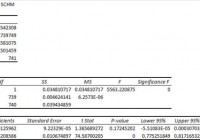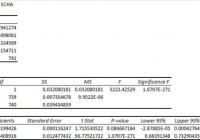My First Look At SCHM And It Falls Just A Little Short
Summary I’m taking a look at SCHM as a candidate for inclusion in my ETF portfolio. SCHM looks just a tad too risky for its high correlation. The ETF has great diversification in its investments, but the value still fluctuates slightly too much. If the risk was slightly lower, I would want to carve out a small space for it. I’m not assessing any tax impacts. Investors should check their own situation for tax exposure. Investors should be seeking to improve their risk adjusted returns. I’m a big fan of using ETFs to achieve the risk adjusted returns relative to the portfolios that a normal investor can generate for themselves after trading costs. I’m working on building a new portfolio and I’m going to be analyzing several of the ETFs that I am considering for my personal portfolio. One of the funds that I’m considering is the Schwab U.S. Mid-Cap ETF (NYSEARCA: SCHM ). I’ll be performing a substantial portion of my analysis along the lines of modern portfolio theory, so my goal is to find ways to minimize costs while achieving diversification to reduce my risk level. What does SCHM do? SCHM attempts to track the total return of the Dow Jones U.S. Mid-Cap Total Stock Market Index. At least 90% of funds are invested in companies that are part of the index. SCHM falls under the category of “Mid-Cap Blend”. Does SCHM provide diversification benefits to a portfolio? Each investor may hold a different portfolio, but I use (NYSEARCA: SPY ) as the basis for my analysis. I believe SPY, or another large cap U.S. fund with similar properties, represents the reasonable first step for many investors designing an ETF portfolio. Therefore, I start my diversification analysis by seeing how it works with SPY. For investors curious about my personal choices, I will probably use (NYSEARCA: SCHX ) in place of SPY. I stick to using SPY in these articles because it is better known. I start with an ANOVA table: (click to enlarge) The correlation is about 94%. Diversification with SPY (or an alternative) will still provide some benefits. At 94%, the diversification benefits won’t be huge but I would still consider SCHM as an addition to a portfolio rather than replacing SPY as a core holding. Standard deviation of daily returns (dividend adjusted, measured since January 2012) The standard deviation is higher. For SCHM it is .8614%. For SPY, it is 0.7300% over the same period. SPY usually beats other ETFs in this regard. Because the correlation is fairly high and the volatility is higher, it will be more difficult for me to find a way to use SCHM for risk adjusted returns. Mixing it with SPY At a 50/50 weighting, the standard deviation of the portfolio is .7837%. Even with 95% in SPY and 5% in SCHM, the standard deviation of the portfolio is .7341%. The strong correlation makes it very difficult to get a level of diversification that is high enough to really offset the additional risk. Why I use standard deviation of daily returns I don’t believe historical returns have predictive power for future returns, but I do believe historical values for standard deviations of returns relative to other ETFs have some predictive power on future risks and correlations. Under standard deviation of daily returns, the S&P 500 is remarkably efficient in long term growth relative to volatility. Yield & Taxes The distribution yield is 1.41%. The SEC yield is 1.33%. Based on the yields, I think the ETF isn’t a great pick for investors nearing retirement and they should consider leaning towards higher yield “value” funds. For a retiree, a position in SPY (or SCHX) still makes sense, but I just don’t see a good way to use SCHM unless it is a very small position. In my opinion, most readers aren’t interested in the case for putting one half of one percent into an ETF. It just wouldn’t be worth the hassle for individual retirees. I’m not a CPA or CFP, so I’m not assessing any tax impacts. Expense Ratio The ETF is posting .07% for an expense ratio. I want diversification, I want stability, and I don’t want to pay for them. That is cheaper than SPY, but more expensive than SCHB. All around, 07% is still a very solid ratio. Market to NAV The ETF is at a .02% premium to NAV currently. In my opinion, that’s not worth worrying about. It is practically trading right on top of NAV. However, premiums or discounts to NAV can change very quickly so investors should check prior to putting in an order. Largest Holdings The portfolio has spectacular diversification. Having less than .60% in any single stock is the kind of diversification I’m willing to pay the higher expense ratio for, but I think this sector of the market is offering a compelling level of risk adjusted returns on an aggregate basis. (click to enlarge) Conclusion I’m currently screening a large volume of ETFs for my own portfolio. The portfolio I’m building is through Schwab, so I’m able to trade SCHM with no commissions. I have a strong preference for researching ETFs that are free to trade in my account, so most of my research will be on ETFs that fall under the “ETF OneSource” program. SCHM doesn’t look like a bad ETF. It isn’t a terrible investment by any means, but I don’t think it will fit in the portfolio I’m building. I’m still defining risk as the deviation of returns, and so long as the historical deviation is fairly accurate, I don’t think I can allocate enough of my portfolio to SCHM to make it worth having the additional position. Even without monetary trading costs or taxes to consider. When my portfolio gets so large that one percent is meaningful, I may reconsider using a small exposure to SCHM. If the correlation was only 83 to 80% or if the standard deviation of daily returns was in the .79% to .81% range I’d be much more likely to consider a 5% allocation to SCHM. If I saw the ETF trading at a .3% to .4% discount to NAV, I’d consider that fairly attractive, but I don’t expect such a discount to exist during open trading hours. Additional disclosure: Information in this article represents the opinion of the analyst. All statements are represented as opinions, rather than facts, and should not be construed as advice to buy or sell a security. Ratings of “outperform” and “underperform” reflect the analyst’s estimation of a divergence between the market value for a security and the price that would be appropriate given the potential for risks and returns relative to other securities. The analyst does not know your particular objectives for returns or constraints upon investing. All investors are encouraged to do their own research before making any investment decision. Information is regularly obtained from Yahoo Finance, Google Finance, and SEC Database. If Yahoo, Google, or the SEC database contained faulty or old information it could be incorporated into my analysis. The analyst holds a diversified portfolio including mutual funds or index funds which may include a small long exposure to the stock.

